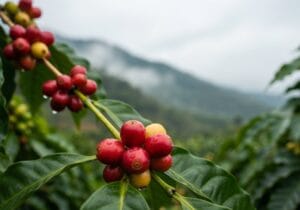Light roast coffee is like the peppy friend in the coffee world—super vibrant, bright brown, and packed with fruity vibes! It skips the burnt stuff, letting those natural flavors pop like a surprise party in your mouth. The roasting process is a delicate dance of time and temperature, so you get those lively floral and nutty notes, especially if you’re using beans from Ethiopia or Latin America. Stick around, and you’ll uncover even more about this tasty journey!
Key Takeaways
- Light roast coffee has a light brown color, lacks oily sheen, and features bright, fruity flavors without burnt edges.
- The roasting process stops after the initial crack, preserving acidity and light color.
- Flavor profiles include vibrant acidity, fruity notes, and floral aromas, influenced by bean origin.
- Ethiopian Arabica and Latin American beans are commonly used for their delicate and vibrant characteristics.
- Freshness is crucial for maintaining the unique flavors and qualities of light roast coffee.
Definition and Appearance
When you think of light roast coffee, picture a sunny morning where everything feels bright and fresh—kind of like the coffee itself!
Light roast beans, with their light brown or tan colors, proudly flaunt their matte finish, like they just rolled out of bed—no shiny oils here! These caffeine gems preserve their original look with clear lines and natural markings (because nobody likes a fake, right?). It’s fascinating how they keep that vibrant appearance, providing a visual impact that hints at bright and fruity flavors! Plus, they don’t get all blistered like those overcooked dark roasts. Interestingly, light roasts retain higher caffeine levels compared to darker roasts, giving you an extra kick to start your day.
Light roast beans shine with their natural beauty, boasting matte finishes and vibrant markings—just like nature intended!
When you spot a “Cinnamon roast,” you know you’re in for a deliciously delightful experience—no burnt edges in sight! What a relief! This unique roast level also contains higher caffeine content than darker roasts, giving you an extra kick to start your day.
Roasting Process
Roasting light roast coffee is like trying to perform a delicate dance—you’ve got to hit those right steps, or it’s game over! This process unfolds through several vital stages, and precision is key. Here’s what happens:
- Drying stage kicks off at 160-200°C (320-392°F), where moisture escapes.
- The browning stage follows, caramelizing sugars above 200°C (392°F).
- You stop right after the initial crack, typically at 425-435°F, preserving that light color and acidity.
- Proper temperature control is essential to avoid turning your light roast into a dark roast disaster.
- Experienced roasters track time and listen for that initial crack, because once it’s gone, it’s like letting go of a balloon—poof!
In short, mastering roasting techniques means treating each bean with care!
Flavor Profile

Light roast coffee takes you on a flavor adventure that’s anything but boring! With vibrant acidity balance, each sip offers a lively brightness that dances on the palate. Here’s a taste breakdown:
| Flavor Aspect | Characteristics | Notable Origins |
|---|---|---|
| Fruity Notes | Berries, stone fruits, tropical | Colombia, Kenya |
| Floral Aromas | Jasmine, hibiscus, citrus blossoms | Ethiopia, Kenya |
| Nutty Undertones | Almonds, hazelnuts | Costa Rica, Honduras |
| Complexity | Layered herbal, fruity | Diverse Regions |
Picture sipping a crisp brew that’s like a fruit basket burst—unexpected and invigorating! The joy’s all in those fruity notes, where every sip says, “Is that a peach or a party in my mouth?” Additionally, light roast coffee tends to highlight unique flavor profiles that are often influenced by the specific growing conditions and origins of the beans. This is particularly interesting given that the diverse genetic diversity of Arabica coffee has a significant impact on the flavors expressed in the brew.
Origin Impact and Selection
While coffee enthusiasts might think any roast can shine, the truth is that origin plays a massive role in selecting beans for light roasts—almost like picking the right partner for a dance; you want someone who can keep up!
Geographic influences make all the difference, as certain bean origins just excel in that lighter roasting domain.
- Ethiopian Arabica beans deliver delicate flavors.
- Latin American coffees flaunt bright acidity and fruity nuances.
- Terroir can dramatically improve light roast qualities.
- Specialty coffee lovers drool over single-origin options.
- Freshness matters—a lot—for those delicate flavors!
Frequently Asked Questions
How Should I Store Light Roast Coffee Beans?
Light roast coffee beans should be stored in airtight containers made of glass or stainless steel. Freshness tips include minimizing exposure to light, temperature fluctuations, and moisture, while portioning for ideal use over time.
Can I Brew Light Roast Coffee With a French Press?
Yes, brewing light roast coffee with a French press is effective. Employing specific brewing techniques improves flavor profiles, requiring careful attention to water temperature, grind size, and steeping time for ideal flavor extraction and balance.
What Grind Size Is Best for Light Roast Coffee?
The best grind size for light roast coffee is medium to medium-fine. This promotes ideal grind consistency and improves flavor extraction, capturing the beans’ delicate notes while avoiding bitterness or sourness from improper extraction techniques.
Is Light Roast Coffee Suitable for Espresso?
Light roast coffee can be suitable for espresso, offering unique flavors and brightness. However, it demands precise brewing techniques to achieve balanced espresso flavor, avoiding bitterness or sourness through careful extraction and temperature management.
Can I Mix Light Roast With Dark Roast Coffee?
Mixing light roast with dark roast coffee is possible, creating a unique flavor balance. However, ideal brewing methods may require adjustments in grind size to improve flavor extraction and achieve desired taste profiles.





